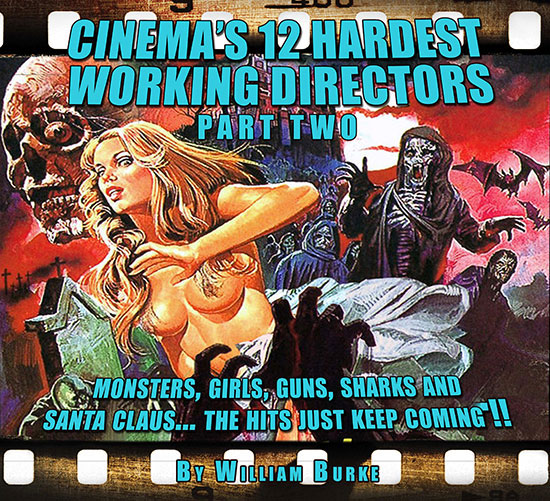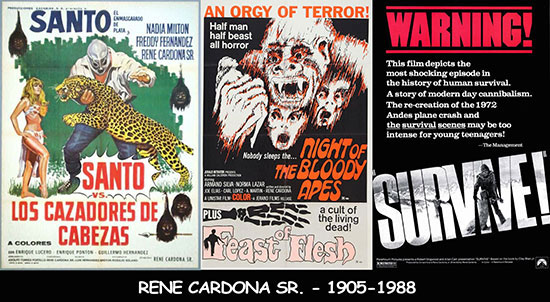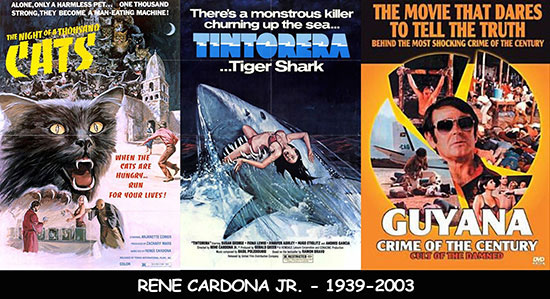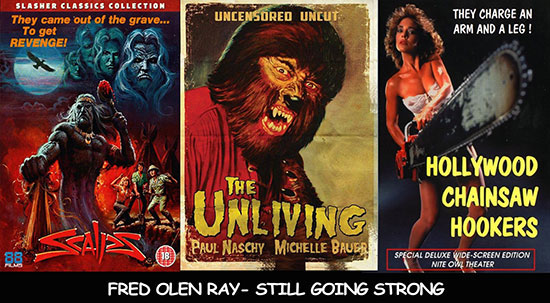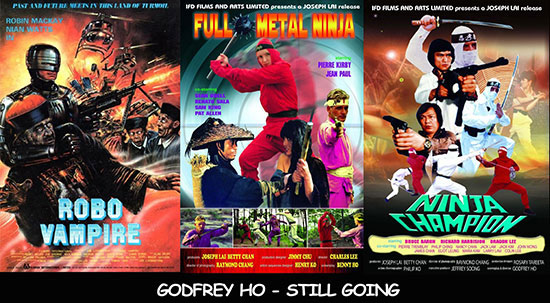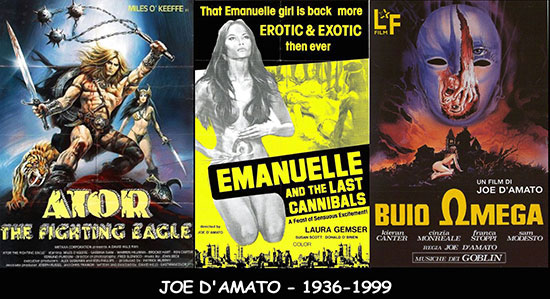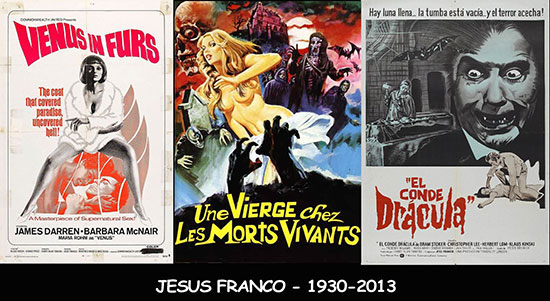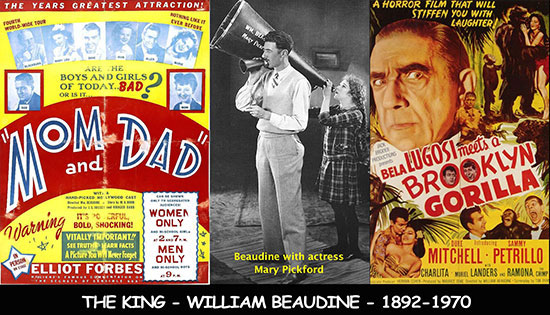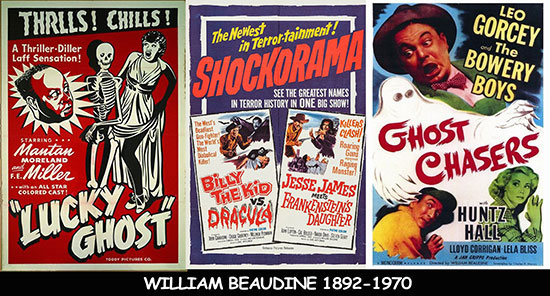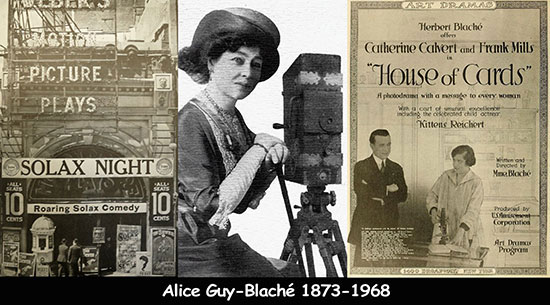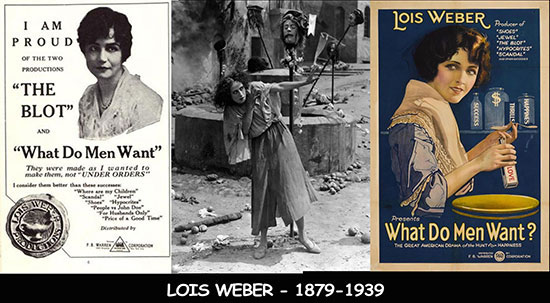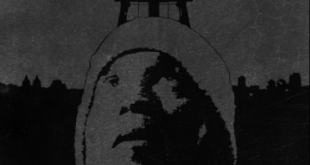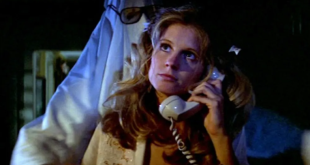We’re back with our list of history’s most prolific film directors. Let’s kick things off with a father-son duo who’ve given us two generations of cinematic insanity. Their shared DNA earned them numbers 6 and 6.5 on the list.
- Rene Cardona – 145 films
Rene Cardona Senior made his career in film the hard way. He was originally a medical student in Havana but was forced to flee the country. Upon arriving in New York, he made ends meet by working as a movie extra. Somehow he managed to hustle that into directing 1929’s Havana Shadows. He relocated to Mexico and established himself as a filmmaker, directing over one hundred films between 1937 and 1986. In 1959, he directed the bizzaro family film Santa Claus, which American exploitation impresario K. Gordon Murray turned into an annual cash cow at kiddie matinees. But this isn’t your usual Santa; this one’s fighting the devil while keeping an international cavalcade of children as prisoners in his celestial palace—it’s surreal. Cardona really hit his stride with a string of Santo and Blue Demon wrestler/monster mash-ups. If you’ve never experienced a Mexican wrestling monster movie, well, you’re in for a treat. Other highlights include the so bad it’s fantastic Wrestling Woman vs. the Aztec Mummy (1964) and The Batwoman (1968)—a blatant but intoxicating rip-off of TV’s Batman. The schlock kept coming with the next watershed being 1976’s torn from the headlines Survive!—the true story of a soccer team who resort to cannibalism after a plane crash in the Andes. Cardona beat several bigger producers to the punch and the film made a fortune. Cardona sadly passed away in 1988 … but his progeny kept the family name alive!
Signature work: Night of the Bloody Apes (1969). It’s hard to tell how much of the salacious stuff was inserted by Americans after the fact, but who cares? It’s packed with face ripping, lady wrestlers, gruesome surgery, gratuitous nudity and horrible dubbing. In other words, you’ll love it!
6.5 Rene Cardona Jr. – 100 films
Like father like son, Junior continued his family’s reign as Mexico’s hardest working film family. What’s particularly amazing is that Cardona Jr. not only directed a hundred films but wrote over sixty of them! He began directing in 1964 with Las Hijas de Elena, which was never released in English. He quickly jumped onto the lucrative English language market with commercial films like A Colt, Five Dollars and Carrion (1967). In 1972, he directed the unforgettable The Night of a Thousand Cats, wherein a globetrotting millionaire seduces women and feeds them to his army of cats. Not impressed? Well ,here comes the juicy stuff. He clamped on to the success of Jaws with 1977’s Tintorera: Killer Shark featuring bloody shark attacks and Susan George having oodles of threesomes. In 1978, he jumped on the very trendy topic The Bermuda Triangle, followed by 1979’s truly tasteless bio picture Guyana: Cult of the Damned, starring Stuart Whitman (Night of the Lepus) as Rev. Jim Jones. That same year he did a biography on Carlos the Jackal even though nobody knew who Carlos actually was. Here’s an odd bit of trivia—Mexican actor Hugo Stiglitz is in almost every Cardona Jr. movie… It’s crazy! By the 1990s, Cardona’s English language releases had tapered off, but he was still going strong in Latin America with the incredibly popular film series La Risa en Vacaciones 1-8. Rene Cardona Jr. passed away in 2003, but never fear, because he left us with Rene Cardona III—and he’s directed 71 movies already!
Signature work: Night of a Thousand Cats (1972). The cinematic shocker that proves no matter how much fake blood you spray on kitty cats, they’re still adorable. And yes, it has Hugo Stiglitz in it.
- Fred Olen Ray – 149 films (and counting)
At an age when your dorm buddies were drinking beer and bragging about how they’d make movies someday Fred Olen Ray was already out there doing it. I’m not saying he was great right out of the gate, but, damn it, he was actually making movies! After his directorial feature debut The Alien Dead (1980) Fred kept chasing his dream without the benefit of film schools or family connections. He learned fast, hustling overseas distribution deals and raising investor money to create a string of deliriously fun B-movies. Like a utility infielder he hopped between the horror, action and T&A genres, including his 1988 Grand Guignol masterpiece Hollywood Chainsaw Hookers. He also directed a string of successful family films like Billy Frankenstein (1998) and Invisible Mom (1996). Besides directing Ray is also a distributor of cult films through his company Retromedia and he’s a semi pro wrestler, grappling under the ring name Freddy Valentine. How fun is that? He’s survived the industry’s many peaks and valleys, including spending a few years knocking out micro-budget skinimax films like 2012’s The Teeny Weenie Bikini Squad. Fred’s directing higher-budget films again, including a string of Christmas movies and even a Steven Seagal flick—and just remember that Steven Seagal is certifiably insane. The fact that Fred’s maintained his sense of humor and sanity through the decades of crazy deals and slashed budgets tells you a lot about the guy.
Signature work: Hollywood Chainsaw Hookers. Its combination of gore, humor, scream queen cast, title and advertising tag line “They cost an arm and a leg!” make this a doctoral thesis on the art of exploitation cinema.
- Godfrey Ho – 152 films
I’m including Ho despite it being almost impossible to tell how much of his film work is original and how much is recycled from films he bought, recut or found under his couch cushions. An average Godfrey Ho movie consists of about fifteen minutes of material directed by Ho with the remainder being footage from unfinished or unsold Asian films, all precariously stitched together with a dubbing track that fails to connect the dots. The incoherent but shoddily entertaining Robo Vampire (1988) is a perfect example. Oh, and every film should have the word Ninja in the title. Allegedly, actor Richard Harrison was so embarrassed by Ho’s films that he gave up acting altogether after completing his contract. Twenty minutes of any Godfrey Ho film will have you in hysterics … but ninety minutes will grind you into emotional submission.
Signature work: Ninja Terminator (1985). There are endless back flipping ninjas, toy robots shooting poison gas and a cast that are clearly not appearing in the same movie. In a nutshell … that’s My Man Godfrey!
- Astride Massaccesi – aka Joe D’Amato – 195 films
D’Amato began as a cinematographer, lending visual style to Italian films like What Have You Done to Solange? (1972) and The Antichrist (1974). He made his directorial debut with 1973’s grisly Giallo Death Smiles on a Murderer, but it was 1975’s Emmanuelle’s Revenge that set the trajectory for his non-stop exploitation career. Between endless Emmanuelle films he dabbled in every genre, aping Max Max with 2020, Texas Gladiators (1980), directing a semi sequel to Caligula entitled Caligula- The Untold Story (1982), and jumping on the Conan bandwagon with Ator, the Fighting Eagle (1982) and its sequels. He first dabbled in hardcore pornography with Porno Holocaust and Erotic Nights of the Living Dead (both 1979) before returning to the more acceptable softcore and horror genres. He scored big with the video nasty Antropophagus (1980) and the erotically charged 11 Days, 11 Nights (1987). Oh, did I mention nuns? Big Joe loved nunspoitation, knocking out a batch of cinema’s steamiest Catholic guilt fests. Through the ’80s D’Amato was shooting exploitation films as fast as Kodak could manufacture the film stock. But sadly the market for Italian films was shrinking, so in 1993 he returned to directing hardcore porn films. Unlike his American counterparts, D’Amato eschewed tacky video productions and continued shooting in glorious 35MM film. He used actual scripts while adding as much period costuming and set decoration as he could borrow from bigger films. He did at least fifteen of these lushly-produced crotch operas like Tarzan X and Marco Polo (both 1994) and Hamlet (1995) but sadly died during pre-production on a film in 1999. Those who knew him say that Joe was a talented craftsman and also a genuinely nice guy.
Signature work: Blue Omega aka Beyond the Darkness (1979). Necrophilia, human taxidermy and incest make strange bedfellows in this lushly-shot gore fest. It’s really disturbing.
- Jesus Franco – 203 films
The words auteur, hack, artist and degenerate have all been used to describe legendary low-budget filmmaker Jesus (Jess) Franco. Amazingly, they’re all appropriate descriptions of a director so prolific that even his pseudonyms are impossible to count. Franco began as an assistant director, co-writer and occasional composer in the Spanish film industry before directing his first film—1961’s The Awful Doctor Orloff. It was a success, igniting a frenzied directorial career spanning every genre including horror, espionage, women in prison, women in convents, soft erotica and hardcore sex. He often shot multiple films at the same time shortchanging the cast while bamboozling his financiers. Fortunately for Franco, he was such a charming rogue that people usually forgave his occasional embezzlement. Christopher Lee was shocked to discover that Franco had slipped acres of nudity into the film Eugenie (1970) after he’d left the set. Apparently Lee didn’t hold a grudge and returned to star in Franco’s best remembered film Count Dracula (1970). It’s almost impossible to tally Franco’s filmography as so many of his films were retitled, reedited (often with hardcore sex) or cannibalized into other productions by the director himself. Franco was also a talented musician who infused his films with an improvised jazz mindset, combining flowing handheld camerawork with eccentric visuals and seemingly erratic, but weirdly rhythmic, editing. Some call his work poetic while others call it garbage but every Jesus Franco film displays the artist’s personal brushstrokes.
Signature work: either Vampyros Lesbos or She Killed in Ecstasy—both offer the director’s signature flowing visuals and perverse plotlines. Just don’t watch Castle of Fu Manchu (1969) unless it’s the MST3K version—life is too short.
And the winner is…
- William Beaudine – 350 feature films!
And finally it’s the man, the legend Bill Beaudine! A guy who, it’s said, never met a take he didn’t like. Beaudine directed dozens of memorable low-budget genre films like Billy the Kid vs. Dracula and Jesse James meets Frankenstein’s Daughter (both 1966). He began as an assistant to the venerable D.W. Griffith and had directed over thirty films before the sound era. He started the sound era strong, directing W.C. Fields in 1934’s The Old Fashioned Way. But after a long working trip to the UK Beaudine had trouble getting back on Hollywood’s A-List. This led to his fascinating—though probably humiliating—trek through every facet of the low-budget film world. Beaudine directed “race pictures” like Professor Creeps and Lucky Ghost (both 1942), dozens of horror films, Bowery Boys comedies and even the notorious Kroger Babb road show classic Mom and Dad, which was allegedly one of the highest grossing films in history! How prolific was Beaudine? Well, in 1944, he directed ten films—and that was just an average year! He directed Bela Lugosi in several films including The Ape Man (1943), Voodoo Man (1944) and the execrable Bela Lugosi Meets a Brooklyn Gorilla (1952).
Beaudine was unfairly given the nickname “One-Shot” by the authors of the book The Golden Turkey Awards. In truth, he always shot enough takes to satisfy his editors and producers … maybe that’s why he got hired 350 times! As if directing 350 films wasn’t enough for one lifetime Beaudine also directed tons of television including 79 episodes of the beloved series Lassie (1954-1974). He even directed episodes of The Green Hornet (1974) making him one of the first directors to work with the legendary Bruce Lee.
Signature work: 1966’s ready made double bill Billy the Kid Versus Dracula and Jesse James Meets Frankenstein’s Daughter. Sadly, these back-to-back films were the director’s swan song.
APPENDIX – An apology to female readers
I’m kind of ashamed that this list has been such a sausage fest. It wasn’t intentional, I was merely judging by the number of films directed as long as a certain number were genre films. But, in closing, I’d like to give female filmmakers the respect they deserve by spotlighting two prolific pioneers. Though very few of their works were genre films they’ve still earned a place on this list and in the hearts of any film lover.
Alice Guy-Blaché – Between 443 and 1000 films, mostly shorts
Alice Guy-Blaché was not only a film director but has been credited as the first filmmaker to work in narrative fiction. She was originally a secretary for France’s fledgling Gaumont et Cie—a manufacturer of cameras. She found the company’s initial cinematic efforts, usually consisting of photographing their own workers, tiresome and asked for a chance to direct. Her first film was the 1896 short subject The Fairy of the Cabbages. She continued her pioneering work, including the 1906 film The Life of Christ, which utilized over three hundred extras. Somewhere between 1907 and 1910 she relocated to New Jersey where she opened Solax Studios, becoming the first woman to own a motion picture company. Over the years she experimented with experimental sound and color as well as being one of the first filmmakers to cast minorities while other directors were using white actors in blackface. Unfortunately, society is rarely kind to female pioneers and a nasty divorce combined with good old-fashioned American misogyny led to her eventual bankruptcy. She returned to France in 1922, never directing another film. Thankfully, over three hundred of Alice Guy-Blaché’s films still exist.
Lois Weber – 138 films
Lois Weber was a writer, director and overall creative force in the silent film industry. She was also one of the first filmmakers to recognize the medium’s power, telling Photoplay Magazine she aspired to produce work, “that will have an influence for good on the public mind.” Beginning in 1911, she worked in conjunction with her husband, with her writing and acting as co-director. Eventually they divorced and she opened her own 12,000-square-foot film studio in Los Angeles. Her work was both respected and profitable and by 1916 she was America’s highest paid film director, earning more than Cecil B. DeMille! She wasn’t afraid to ruffle the censors by showing full frontal nudity in 1915 and openly featuring abortion and birth control in a film the following year. Between 1911 and 1929 she directed 137 films including the 1913 home invasion chiller Suspense, featuring Lon Chaney (Phantom of the Opera) in a small role. The 1920s became a rough time for independent studios, doubly so for one run by an upstart woman. As a result, Weber’s career slowly declined. After a seven-year hiatus she directed her only talkie, White Heat (1934), which was also her last film. She died of a bleeding ulcer in 1939. The male-dominated industry wasn’t kind to this female pioneer. For two decades Lois Weber had been regularly featured on the cover of Variety magazine; when she died, they ran an obituary that was less than two paragraphs.
Did anyone notice that history’s most prolific female directors both worked in the silent era? We still have a long way to go in terms of parity.
Love ’em or hate ’em those were the world’s hardest working movie directors. If you think I missed any or have some information to add, just hit the comments button.
Make sure and check out 12 Hardest Working Directors – Part 1
 Horror News | HNN Official Site | Horror Movies,Trailers, Reviews
Horror News | HNN Official Site | Horror Movies,Trailers, Reviews
